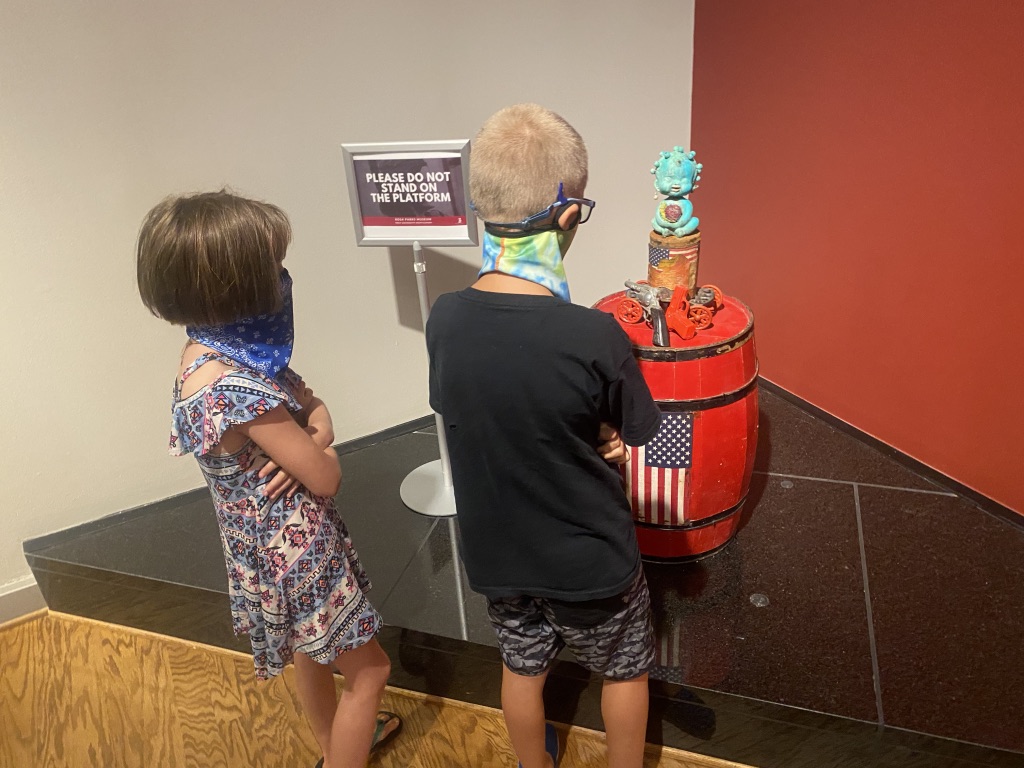
Driving into Montgomery was a visceral experience, it was picturesque, well maintained, historic and quaint. In the days to come I would learn that it played a significant role in American history, however, at the time of arriving I was still naive to its relevance. But after a short drive around downtown it was obvious that this would be one of the most potent stopping places along our journey. As we entered the plaza we saw the Court Square Fountain, in the year that followed the protests by BLM activists around the US the circular sidewalk around the fountain is painted with the words, Black Lives Matter. Across the street from the fountain is a statue of Rosa Parks, just standing outside the very building where she worked. Up the street you see the view of the Alabama capitol building, along the route to the capital is the Dexter Avenue Memorial Baptist Church, where Dr. Martin Luther King Jr. was the pastor from 1954-1960. Like many other important facts from American history that I did not know, I was quite surprised to learn that Montgomery was the original capital of the confederacy. It wasn’t until I drove past the First White House of the Confederacy in downtown Montgomery, where Jefferson Davis and his family lived, that I realized it had been here before the capital of the confederacy moved to Richmond Virginia. We also drove past the historic train station, a local hub of artisan markets and community events, located directly above the Alabama river front. Making this place the perfect site for human trafficking, by rails and boat, this town was ripe for importing and distributing enslaved people around the south. In addition to its pivotal role in the slave trade, it was a prominent role in reconstruction, Jim Crow, Civil Rights and most recently Black Lives Matter protests. Montgomery was overwhelming in its beauty and its horror, and in the days to come we would be blown away by the willingness of the people and places to openly acknowledge all that Montgomery was, and is, in the lives of its Black community.
We had booked two nights in an airbnb in Montgomery, in fact in Old Town Alabama, a historic neighborhood of old buildings (most of which are now offices of chiropractors, realtors and museums). The historic house we stayed in was perfect for us, although it had a kitchen (which looked as if it had been added onto the house many years after the original building was constructed) it lacked an oven / stove. Luckily, we came prepared to camp so we used our small camp stove outside to cook our pasta, oatmeal, etc.
In the evenings we would walk down the road to a community park and play tag with the kids. Because we were just blocks from downtown we could see the lights from the local minor league baseball game and hear the cheers of the fans. We arrived in Montgomery on Friday, July 2 and little did we know that this community would be lighting off fireworks every night from then through the 4th of July and we could see them from right down the street from our place. Upon arrival to this historic house, undoubtedly built with enslaved labor as was much of the rest of the downtown area, we added another night to our stay. We knew that this would be a town juicy with Black history and we wanted to have ample time to take it in.
Dr. Richard Bailey – A Day with a Montgomery Historian

We reached out to Dr. Bailey, a Montgomery native, through the recommendation of a dear friend who had met him on her own journey into Montgomery to explore its history. Hiring a tour guide is not something that Jay and I are in the habit of doing. However, in this case it was an intimate and in depth look at Montgomery that we would have missed entirely. After taking about an hour in the Legacy Museum (much more on the Legacy in the next section) we met Dr. Bailey and, wearing our masks, we piled into our rental van to drive around the town. He was a walking encyclopedia of knowledge about all things Montgomery! He knew where the homes of every important person who contributed to the civil rights movement were, he knew most of them personally, and took us through once thriving Black communities of Montgomery that, like we had seen in New Orleans and Mobile, that had been devastated by the building of a major freeway through their neighborhoods.
I think that I can speak for my whole family when I say that the highlight of our time with Dr. Bailey was that he had arranged for us to be given a private tour of the parsonage of Trinity Lutheran Evangelical Church. Dr. Bailey explained how the church was located at the boarder of the Black and white neighborhood and was a mixed congregation. During the beginning of the civil rights movement the reverend in residence was Robert Graetz, a white man who supported the Montgomery bus boycott and would drive his Black neighbors and friends to do their shopping or to get to work. During the years that he lived in Montgomery with his young family the parsonage where they lived next door to the church was bombed 3 times. Today it is run down but well loved by members of the community who took time out of their Saturday to meet us to give us a tour and tell us about their experience growing up Black in Montgomery during the civil rights era. We met Dee and Nelson on the porch of the parsonage and they first expressed to us how few people come to hear the stories and that they are trying to raise enough money to put the parsonage back into habitable condition so that they can give tours and perhaps even create a truly historic Airbnb that folks who are seeking first hand contact with civil rights sites could stay at. Dr. Bailey had arranged this opportunity to not only walk through this important historical site of white allyship, something I was grateful to experience and have the kids experience, but also to talk with Dr. MLK’s former barber. Nelson had cut Dr. King’s hair and had had a barbershop just down the street from the King residence in Montgomery. On his way home, Nelson said that in order to delay going home to the craziness of the young children and busyness of the house Dr. King would just come to the barbershop to sit in the back and write. Nelson said that he would often throw away versions of his writing in the waist basket and Nelson regretted not saving those papers. At the time that Dr. King was living in Montgomery he was not known as the Civil Rights giant that he would later become. Of those who knew him he was either very well liked, or not liked at all is what we were told by our tour group. Nelson also told us about living in Montgomery through the end of segregation. He recalled the first time he dared to go into a formally segregated restaurant. He and his wife boldly walked in and took a seat. Upon seeing them get comfortable the band began playing Dixie. Nelson and his wife immediately got up and left feeling fearful for their safety and as they left the band played Bye Bye Blackbird. Dr. King had once asked Nelson about how it was for him to live in Montgomery during the end of segregation and Nelson recounted this story to him. Nelson told us that at the end of the story Dr. King said, “Well at least they didn’t play Swing Low Sweet Chariot, coming for to carry you home.” Jay and I discussed this story later and we both interpreted Dr. King’s meaning in totally different ways. I wonder what you, reader, think he might have meant?



The Legacy Museum – From enslavement to Mass Incarceration
400 N Court St, Montgomery, AL 36104, (334) 386-9100

This museum is FREE but does require tickets in advance to be shown at the door
WOW! This museum is interactive and does not hold back. The EJI (Equity and Justice Initiative) delivers historical events and information in a way that even our three children were captivated by. As you enter the building, once a warehouse where humans were locked up and prepared to be sold at one of the local slave auctions after being transported into Montgomery by train or boat, there are cells that each have a hologram of a person telling you their story. A ghostly portrayal of some of the people that would have been kidnapped and held in this dark and dingy warehouse, pleading for their freedom, their children or some hope that they might be spared. As you move through the museum images, videos and writings tell the story of how our country moved from the era of legal slavery, to Jim Crow (an era where Black residents could be lynched without trial for pretty much anything they were accused of) into the era of the “War on Drugs” and mass incarceration, which has brought us to today in which 1 in 4 young Black boys will end up in prison. The way the Legacy takes you through this journey is painful but very simple, I felt like our kids could understand through the visual imagery all the different periods in America’s history.
The National Memorial For Peace and Justice – AKA The Lynching Memorial
417 Caroline St, Montgomery, AL 36104, (334) 386-9100

This memorial is FREE but does require tickets in advance to be shown at the door
This memorial, also part of the EJI, was created with a tremendous amount of research and artistry. The project began in 2010 to identify and understand racial terror across the southern states by visiting the sites of lynchings and collecting soil from places where killings took place. Markers have been placed at many of the locations to commemorate the sites, and the lives that were taken on them, as well as to change the cultural landscape to one that acknowledges the true history of America. Jars containing the earth from each site are placed at both the National Memorial for Peace and Justice in the visitors center, in addition to inside the Legacy Museum.
The memorial itself is breathtaking, from the provocative sculptures of African, and African American people, to the 800 columns that each represent a county in America where the killings took place including the identifiable names of the victims of the lynchings. The memorial is located up on a hill in Montgomery and is guarded on multiple sides, Dr. Bailey informed us that KKK vandalism is still alive and well in Alabama and many of the sites that acknowledge America’s true history are in jeopardy of being destroyed. Much like the plaque at the site where the body of Emmitt Till was found in the Tallahatchie River had been shot up just 2 years ago by members of a fraternity at the University of Mississippi, these memorials are targeted by Americans who still uphold racist values. Understanding where and why these racist beliefs exist is part of the work that the EJI, Dr. Bailey and our family all have in common. Looking into the depths of horror and hatred with a genuine curiosity is an essential element to actually having meaningful conversations that can lead to real change and hopefully a more peaceful and loving society. Easier said than done.
The day we happened to make it there was USA’s “independence day”, the 4th of July. The pain that comes with the awareness that many Black and brown Americans do not experience the same sense of freedom as those of us in white bodies do is crippling. In these debilitating moments of pain I understand why so many do not choose to look at this history, and present, reality. It hurts so deeply.
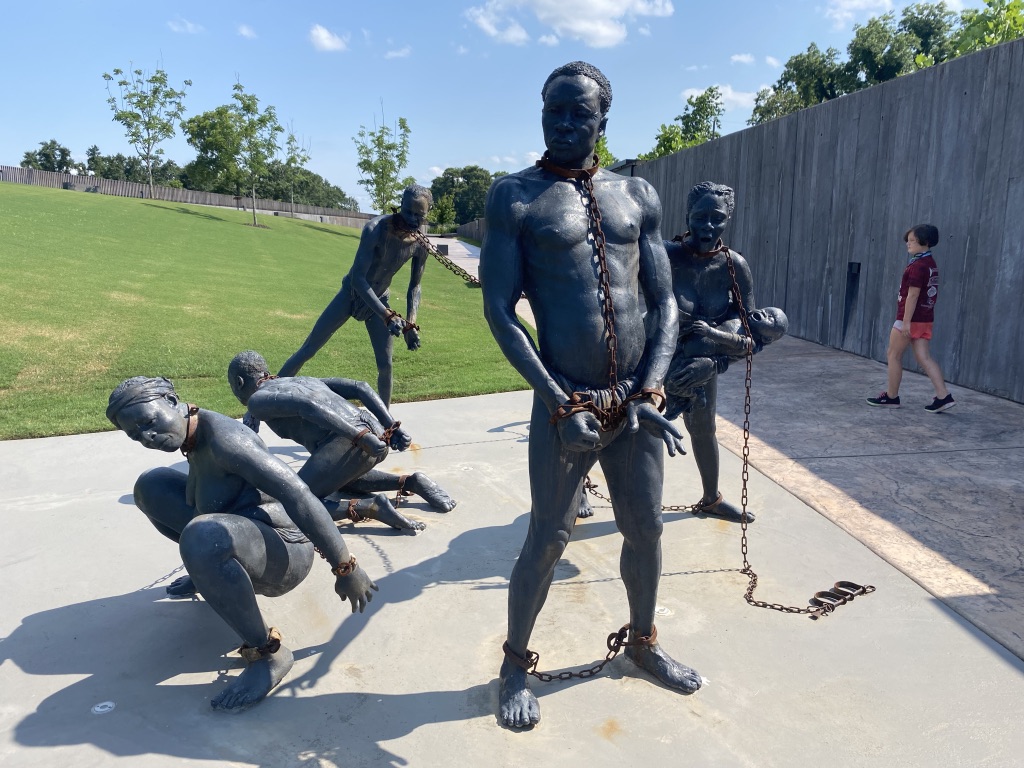


Cassie posted on Facebook July 4, 2021:
The National Memorial for Peace & Justice.
I just walked through, yes it is open today!
AKA The Lynching Memorial. Remember the lives of thousands of Black lives brutally taken in the hands of racism in America. We cannot move forward until we confront OUR past.
Let us not forget – or more like – decide to look away. Today is not a day of independence for many of our brothers and sisters.
“Until we are all free, none of us are free!”
The Civil Rights Memorial Center
400 Washington Ave, Montgomery, AL 36104, (334) 956-8439

Monday – Friday 9 a.m. to 4:30 p.m., Saturday 10 a.m. to 4 p.m.
Adult admission $2, Children are admitted free of charge
Just around the corner from the Dexter Church where Dr. King held services, is the Civil Rights Memorial Center. Unfortunately, at the time that we were in Montgomery it was closed. However, outside the building is the Civil Rights Memorial created by Maya Lin. The stunning round piece of black granite has a timeline of the civil rights era and names of prominent activists. The water running over the sides of the memorial invite visitors to touch the surface of the granite, intended by Maya Lin as a tactile experience that connects the observer with the names and dates engraved. If you’re in the area this memorial is a must touch experience.
Dexter Avenue King Memorial Baptist Church
454 Dexter Avenue, Montgomery, AL 36104, (334) 263-3970
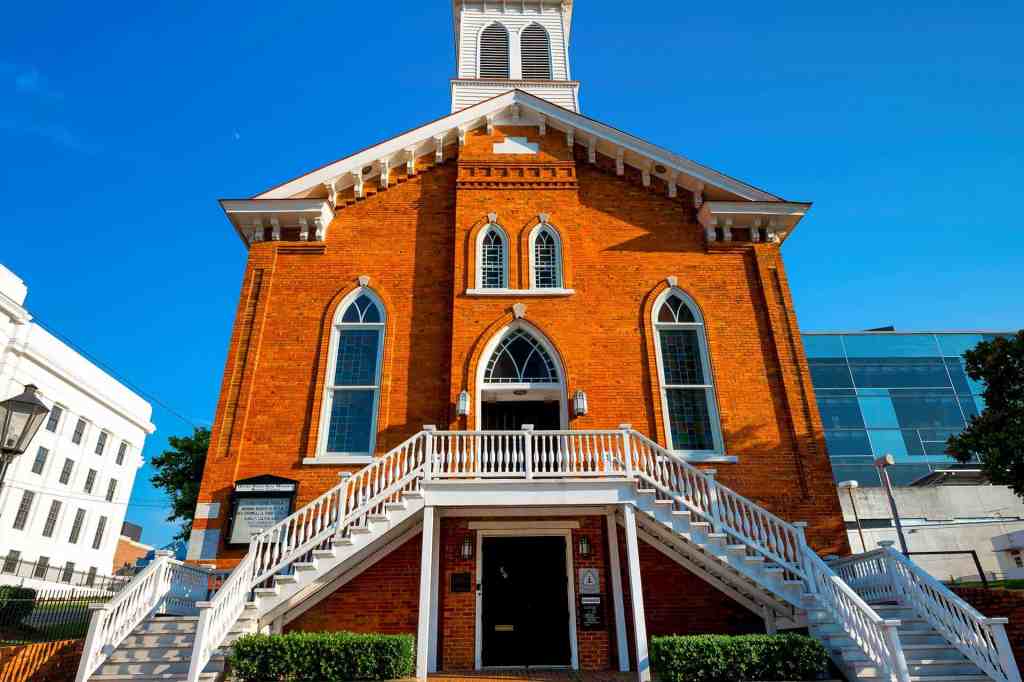
Although we could not enter the church, due to Covid 19, I highly recommend visiting the site where Dr. King was a reverend during the Montgomery Bus Boycott, between the years of 1954 and 1960. Although Dr. King had grown up in a nice neighborhood in Atlanta and had little experience of being forced to give up his seat on a bus, he became the voice of many who did not have the audience that Dr King had. During our time with Dr. Richard Bailey he told us the story of a day that Martin Luther King Jr. was traveling with his father from Atlanta to Boston and they were forced by white riders to stand for hours in the back of the bus. This one incident gave him an understanding of the experience that working class Montgomery residents had everyday as they would commute, the dehumanization of by being forced to stand to allow a white person to take their seat for no other reason other than for their melanated skin.
309 S. Jackson Street, Montgomery, AL 36104, (334) 261-3270
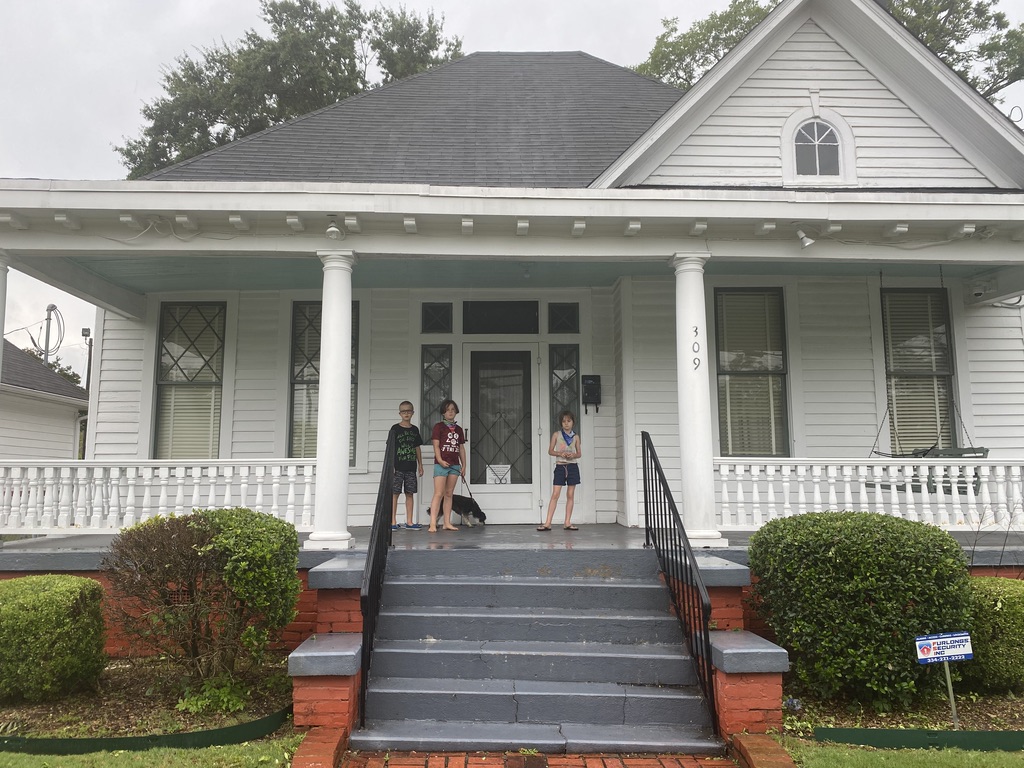
Hours: Monday-Friday 10am-4pm; Saturday 10am-2pm
Admission Fee: $7.50 Adults; $5.50 Children under 12
Although the museum was closed, standing on the porch of the home to Dr. King and his family between the years of 1954 to 1960 was poignant. To have our kids sitting on the step where he surely sat with his young children somehow gave us the illusion of being there with him and his family.
252 Montgomery St, Montgomery, AL 36104, (334) 241-8615
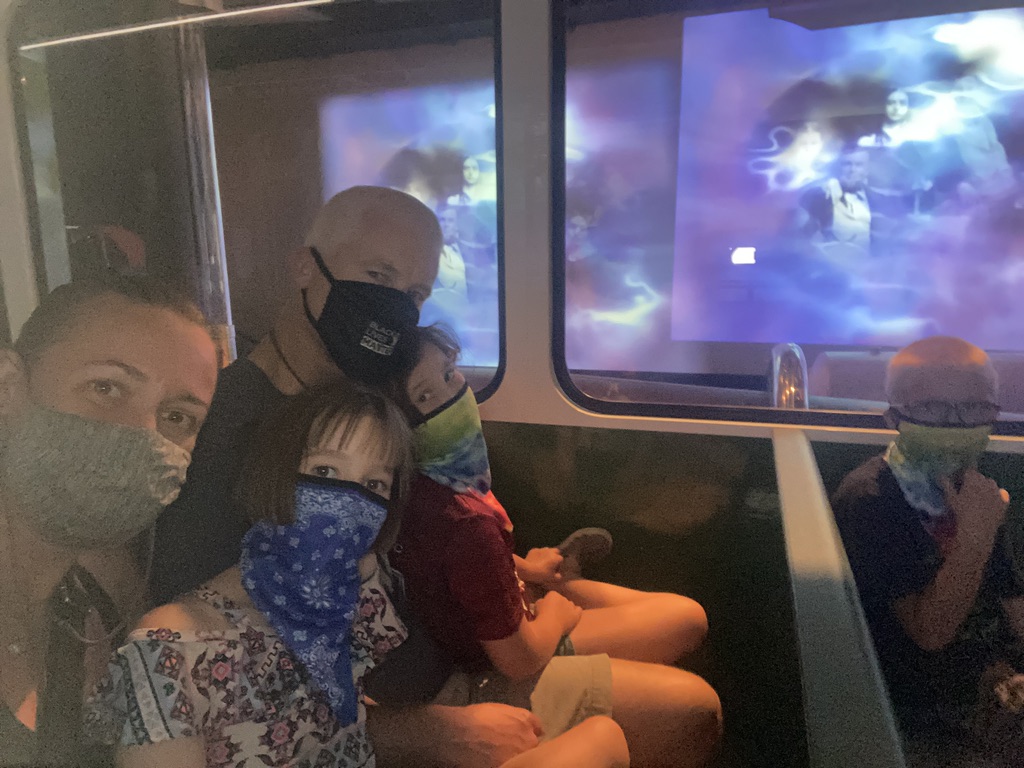
Discount price for both Museum & Children’s Wing: Over 12 years of age: $14, 5-12 years of age: $10, Alabama College Student: $1.00 off admission with a Valid Student ID, Military: $1.00 off admission with a CURRENT military ID, $2.00 off with a CURRENT military ID for both Museum and Children’s Wing, AARP: $1.00 off admission with CURRENT AARP card, AAA: $1.00 off admission with CURRENT AAA card, Teachers: $1.00 off admission with Valid Teacher ID, Groups of 25 or more: $1.50 off admission for Museum or Children’s Wing
The Rosa Parks museum was one of the most kid friendly museums in our travels. Troy University manages this site, it was a beautiful tribute to Rosa Parks. Known as the “mother of freedom”, she was not the first person of color to refuse to give up their seat to move to the “colored section” in the back. However, she was undoubtedly the most famous. Her refusal to give up her seat led the civil rights movement into a pivotal moment, the Montgomery Bus Boycott. She was selected by Nixon, the president the Montgomery chapter of the NAACP, where she served as the secretary, along side her husband who was a long time member as well. At the museum a bus simulator takes the riders on a journey through important historical moments in civil rights history. Narrated by a talking robot the journey is informative for visitors of all ages. The rest of the museum is a library and art gallery featuring permanent and revolving exhibits. When we were visiting there was a powerful exhibit by artist William Little who used racist artifacts from the mid 20th century such as black faced baby dolls (AKA “mammy” dolls), tea bags, Ku Klux Klan hoods and other items that signify racism blatantly and subconsciously.


